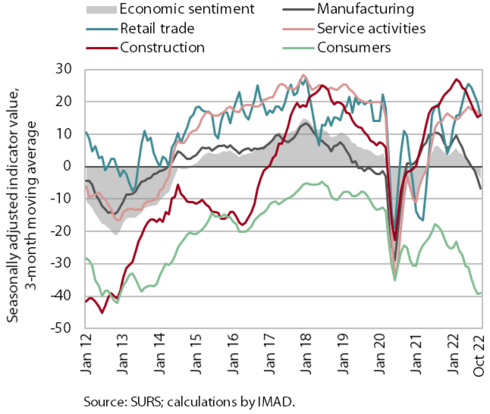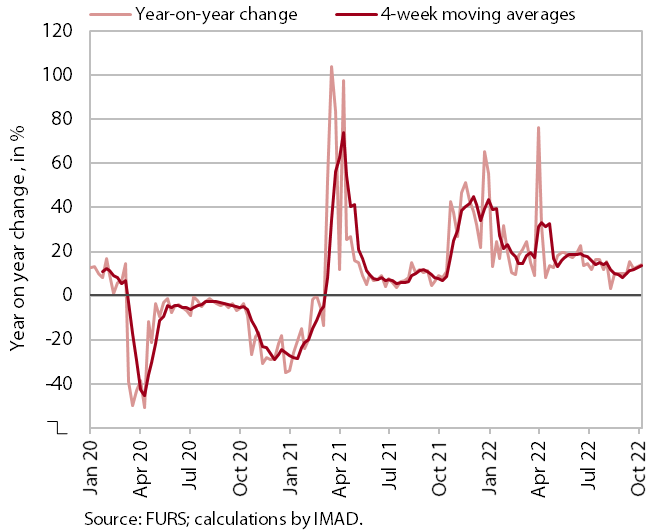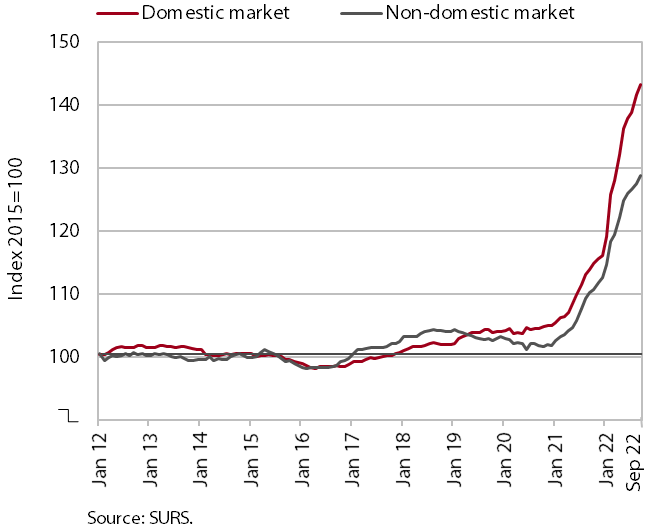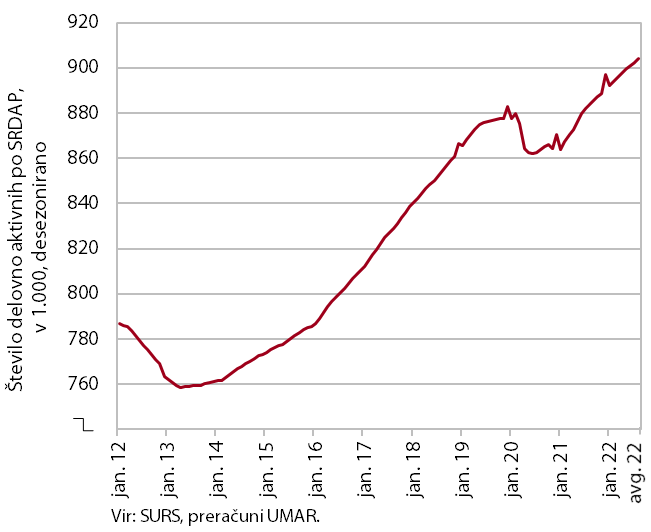Charts of the Week
Current economic trends from 17 to 21 October 2022: economic sentiment, value of fiscally verified invoices, slovenian industrial producer prices and number of persons in employment
The economic climate is deteriorating and the year-on-year decline in confidence is most pronounced among consumers and in manufacturing; compared to last October, confidence improved only in retail trade, although this segment saw the sharpest month-on-month deterioration in confidence. Between 2 and 15 October 2022, the value of fiscally verified invoices was up 14% year-on-year in nominal terms amid high price growth, with the low base associated with the tightening of COVID-19 measures last autumn contributing to the slightly stronger growth since mid-September. After slowing for several months, the year-on-year increase in Slovenian producer prices accelerated slightly again in September (to 21.3%) under the impact of rising energy prices. Year-on-year growth in the number of persons in employment in August was 2%, similar to the previous two months and slightly lower than at the beginning of the year. In the first eight months, the number of people in employment rose by an average of 2.8% year-on-year.
Economic sentiment, October 2022

The economic climate deteriorated further in October and remained below the long-term average. Compared to the previous month, confidence in retail trade deteriorated the most, followed by manufacturing and service activities. Consumer sentiment was somewhat more optimistic than in September, and sentiment also improved in construction. Year-on-year, only confidence in retail trade is higher, while it is significantly lower than a year ago in other activities. The sharpest year-on-year decline in confidence was recorded among consumers, where it is at the level of April 2020, and in manufacturing. Amid high inflation, consumers are increasingly pessimistic about the future economic situation of the country and the financial situation of households, and manufacturing companies are scaling back their expectations for production and exports amid high prices of energy and other commodities, and supply chain problems.
Value of fiscally verified invoices, in nominal terms, 2–15 October 2022

Amid high price growth, the value of fiscally verified invoices between 2 and 15 October 2022 was 14% higher year-on-year in nominal terms and 16% higher than in the same period of 2019. Year-on-year growth was similar to the previous two weeks, when it increased slightly, mainly due to a lower base last year as the recovered/vaccinated/tested rule was expanded to users of most services in mid-September last year. The largest contribution to year-on-year growth came from the 13% nominal growth of turnover in trade, which accounted for more than three-quarters of the total value of fiscally verified invoices issued. Higher turnover growth in accommodation and food service activities, which almost doubled (18%), mainly due to robust growth in food and beverage service activities, also had a major impact on growth.
Slovenian industrial producer prices, September 2022

The year-on-year increase in Slovenian producer prices had gradually slowed in recent months before rising slightly again in September (to 21.3%). This was mainly due to the renewed increase in the growth of prices on the domestic market, where, as in August, energy prices rose the most (they were about 1.1 times higher year-on-year), but also to the increase in consumer goods prices (16.9%). The year-on-year increase in the growth of producer prices in the groups of intermediate goods (19.8%) and capital goods (10.5%) slowed further as the economic activity slowed. Prices on foreign markets rose year-on-year with a dynamics similar to that in August. The high, almost 30% monthly increase of energy prices stands out (23.3% year-on-year), but its contribution to overall growth is relatively small due to its low weight (1.8%). Year-on-year, the price increase in the intermediate goods (25.4%) and consumer goods (8.4%) groups slowed down slightly.
Number of persons in employment, August 2022

Year-on-year growth in the number of persons in employment in August was similar to the previous two months (2.3%) and slightly lower than at the beginning of the year. It remained high in construction, which faces significant labour shortage. Employment of foreign workers has recently been increasingly contributing to overall employment growth – in August, foreign workers contributed 73% to year-on-year employment growth. Consequently, the share of foreign nationals among all persons in employment is also increasing, up 1.4 p.p. to 13.6% over the last year. Activities with the largest share of foreign workers are construction (47%), transportation and storage (32%) and administrative and support service activities (26%). In the first eight months, the number of people in employment rose by an average of 2.8% year-on-year.
